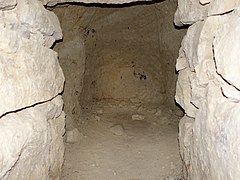Tomb of Tholos from Platyskinos

The Tholos tomb of Platyskinos ( Greek Θολωτός Τάφος Πλατύσκινου Tholotos Tafos Platyskinou ) is a late Minoan round tomb with a cantilevered dome and associated dromos in the east of the Greek island of Crete . It is located in the municipality of Sitia in the Lasithi regional district , about 1.6 kilometers southeast of the village of Achladia ( Αχλάδια ). As Tholos is known, among other things, the circular buildings of Bronze Age domed tombs of the Mediterranean area .
Location and history
The Tholos grave of Platyskinos is surrounded by olive plantations at about 260 meters altitude southeast below the 301 meter high Kefala Platyskinou ( Κεφάλα Πλατύσκινου ) in a small valley. It can be reached off the road on a dirt path. The north coast of Crete at the bay of Sitia is about 5.9 kilometers as the crow flies . The closest excavation site, that of the Minoan villa of Achladia , is located on the small elevation Riza ( Ρίζα ) on the northern slope of the Kefala Platyskinou 900 meters north of the Tholos tomb.
The underground dome tomb was discovered in 1939 by Nikolaos Platon and partially excavated . From 1952 he continued his excavations. A nine meter long dromos (corridor), which leads slightly downwards from the northeast, is in front of the actual grave building. It is framed with dry stone masonry. The trapezoidal entrance leads to a round room that closes off at the top with a cantilever vault made of dry masonry in the form of a cone . The diameter of the room is 4.08 meters, the height 4.16 meters. Opposite the grave entrance there is a smaller passage to a probably not completed side chamber. The lintels and thresholds of the entrance and passage each consist of a hewn stone . Recesses at the main entrance and their threshold were possibly used to anchor a wooden door.
Clay vessels and three sarcophagi were found in the Tholos tomb of Platyskinos . The sarcophagi were painted with religious symbols and octopuses. According to the finds, Nikolaos Plato dated the grave to the late Minoan phase SM III. It was established in the years from 1400 to 1220 BC. Built and used for more than 100 years. The Tholos tomb at Platyskinos is unique in eastern Crete. It resembles the dome tomb A in Phourni near Archanes and is only slightly smaller in diameter. Parallels to the Mycenaean Tholos tombs led to the view that this type of tomb was introduced to Crete by Mycenaean Greeks. The grave of Platyskinos is surrounded by simple shaft graves. The associated settlement was probably located above the cemetery, where ancient terraces made of large stones and structures that have not yet been excavated can be seen.
- Interior views of the Tholos tomb
literature
- Nikolaos Plato : Άνασκαφαί περιοχής Σητείας: ΥΜ ΙΙΙ Θολωτός Τάφος Αχλαδιών. In: Η εν Αθήναις Αρχαιολογική Εταιρεία (Ed.): Πρακτικά της εν Αθήναις Αρχαιολογικής Εταιρείας. Volume 107, 1952, pp. 643-646 ( PDF file ).
- Olivier Pelon: Tholoi, tumuli et cercles funéraires. Diffusion de Boccard, Athens 1976, pp. 260-261
- Metaxia Tsipopoulou, Lucia Vagnetti: Exploration at Achladia and its Relation to Research on Minoan Occupation in the Area of the Sitia Bay . In: Metaxia Tsipopoulou, Lucia Vagnetti (ed.): Achladia: Scavi e Ricerche della Missione Greco-Italiana in Creta Orientale (1991-1993) . Gruppo Editoriale Internazionale, Rome 1995, ISBN 978-88-8011-071-2 , p. 11–14 (English, digitized version [accessed February 13, 2017]).
Individual evidence
- ↑ Olivier Pelon: Tholoi, tumuli et cercles funéraires. Diffusion de Boccard, Athens 1976, p. 260 ( partial view ).
- ↑ a b c d e Archaeological places. Grave Achladion. Sitia Development Organization, 2016, accessed February 12, 2017 ( Greek ).
- ↑ Περιοχή Σητείας. Αχλάδια. Sitia Development Organization, 2016, accessed February 12, 2017 (Greek).
- ^ Paul Lemerle : Chronique des fouilles et découvertes archéologiques en Grèce in 1939 . In: Bulletin de correspondance hellénique . tape 63 , no. 1 , 1939, Crète, p. 323 (French, digitized [accessed February 12, 2017]).
- ^ Lambert Schneider : Crete: 5000 years of art and culture; Minoan palaces, Byzantine chapels and Venetian city complexes . DuMont, Cologne 1998, ISBN 978-3-7701-3801-2 , Minoan and Byzantine sights in the hinterland of Sitia, p. 232 ( digitized version [accessed February 12, 2017]).
Web links
- Platyskinos. In: Digital Crete: Archaeological Atlas of Crete. Foundation for Research and Technology-Hellas (FORTH), Institute for Mediterranean Studies(English).
Coordinates: 35 ° 9 ′ 39.7 " N , 26 ° 4 ′ 22.6" E




